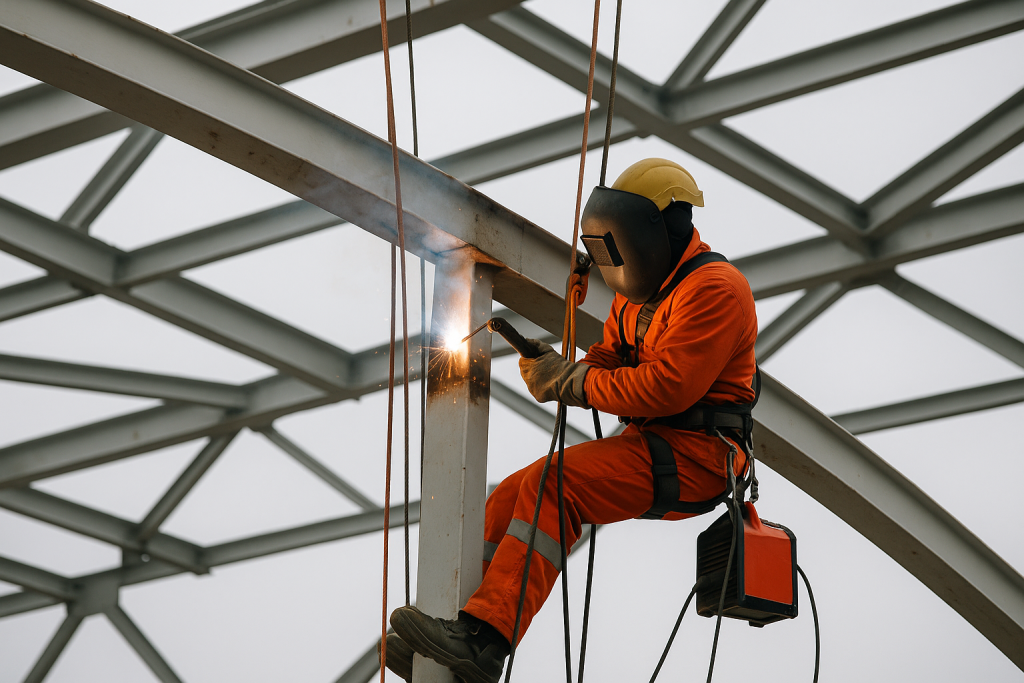Welding at height for the restoration and repair of metal structures: techniques and methods

Welding at height is not just a complex process, but also a special skill that requires not only experience but also high precision. In such conditions, when access to structures is limited or non-existent, each stage of work requires a clear organization and the right equipment. In this article, we will look at the main methods of welding at height used to repair and restore metal structures, as well as reveal the features of techniques that guarantee high efficiency and safety.
Basic methods of welding at height
1. Electrode welding (arc welding)
This is one of the most common methods for welding steel structures at height. An electric arc creates a high temperature that melts the metal and creates a strong weld. This method is ideal for working at high altitudes where fast and reliable welding is required.
Why this method is popular:
- Easy to use.
- Reliable in making welds on thick structures.
- Suitable for both external and internal welds.
Electrode welding is a win-win option for repairing metal structures of buildings, roofs, pipes and other large elements at height.
2. Tungsten arc welding (TIG)
Argon arc welding is used for thinner metals or for work where weld accuracy is important. This method is usually used to work with stainless steel, aluminum or other specialty metals. Crucible welding produces welds with minimal defects and good quality.
Advantages of the method:
- Suitable for working with thin metals.
- High cleanliness of the weld.
- Ideal for restoration work where aesthetics are important.
This method is indispensable for precision work on facades, restoration of historic buildings or repair work on metal structures where high quality welding is required.
3. Magnetic welding
Magnetic welding is an innovative method that allows you to perform welding work in confined spaces. A system of magnetic fields holds the metal, which greatly simplifies the welding process. This is suitable for work in confined spaces where conventional welding would be difficult.
Why it is useful:
- No need for manual metal holding.
- Increased accuracy and speed of work.
- Ideal for cramped working conditions.
Magnetic welding helps to weld metal structures even in tight spaces, making it an important tool for working at height.
4. Gas welding
Gas welding using acetylene and oxygen is another method used for working at height. It makes it possible to work where other methods are not suitable, such as in small areas or where it is necessary to create high temperatures for heat treatment of metal.
Advantages:
- Ideal for spot welding applications.
- Easy to use and mobile.
- Safe and effective for confined spaces.
This welding method is excellent for repairs in difficult conditions where access to the object is limited.
How to organize welding work at height
Welding work at height requires careful preparation. Here are some aspects to consider when planning and performing such work:
Equipment selection
To perform welding work at height, it is necessary to use special equipment that allows you to work at high heights. In particular, these can be mobile welding units that do not require connection to the electrical grid. It is also important to choose the right lifts or climbing equipment that will ensure safety when working at height.
Safety of work
Welding at height always involves an increased risk, so adherence to safety standards is extremely important. Welders must be insured, have the appropriate equipment for working at heights, and receive safety training. It is also important to regularly check equipment for compliance with standards and defects.
Workflow organization
The organization of work at height should include detailed planning and coordination with other teams that may be working at the site. It is important to ensure proper control over welding operations, as well as timely assessment of possible risks that may arise due to weather conditions or limited access to the work area.
Why it is important to choose the right welding method at height
Choosing the right welding method at height is not just a technical issue, but also a safety issue. If the chosen method does not meet the conditions, it can lead to defects in the weld, which will subsequently have a negative impact on the durability of structures. Therefore, before starting work, it is necessary to clearly understand which welding method will be the most efficient and safe for a particular situation.
Interesting articles:
Removing hazardous trees in dense urban areas: how to avoid damaging utilities
